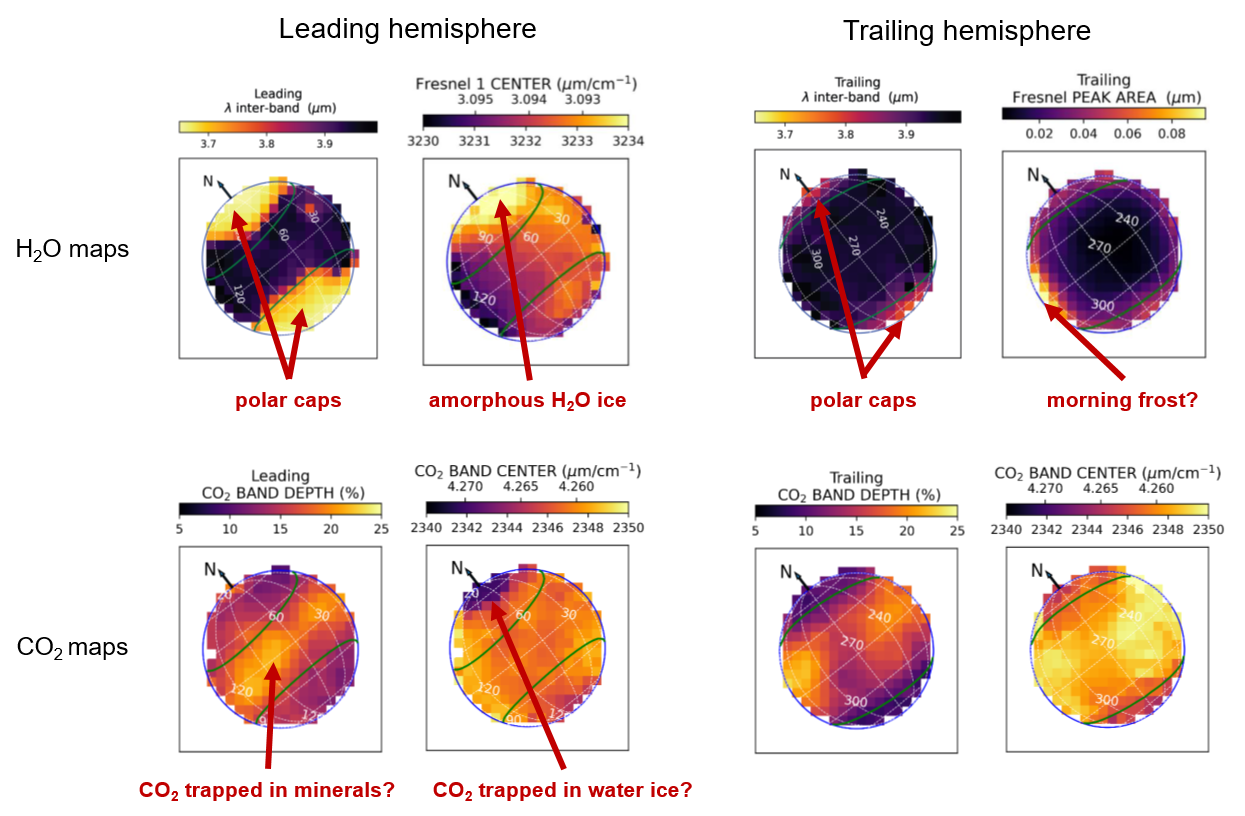Composition and thermal properties of Ganymede's surface from JWST/NIRSpec and MIRI observations
- 1Univ. Grenoble Alpes, CNRS, IPAG, 38000 Grenoble, France (olivier.poch@univ-grenoble-alpes.fr)
- 2LESIA, Observatoire de Paris, Université PSL, Sorbonne Universite, Université Paris Cité, CNRS, 92195 Meudon, France
- 3Faculty of Aerospace Engineering, Delft University of Technology, Delft, The Netherlands
- 4Leiden Observatory, Leiden University, PO Box 9513, 2300 RA Leiden, The Netherlands
- 5Department of Astronomy, University of California, 22 Berkeley, CA 94720, USA
- 6Department of Earth and Planetary Science, University of California, 22 Berkeley, CA 94720, USA
- *A full list of authors appears at the end of the abstract
We present the first observations of Ganymede by the JWST (ERS #1373) (Bockelée-Morvan et al., 2024). NIRSpec IFU (2.9–5.3 μm) and MIRI MRS (4.9–28.5 μm) observations were performed on the Leading and Trailing hemispheres, with a spectral resolution of ∼ 2700 and a spatial sampling of 0.1 to 0.17". We analysed the spectral signatures and brightness temperatures, and their spatial distribution on the surface. Reflectance spectra show signatures of water ice, CO2 and H2O2. An absorption feature at 5.9 μm, with a shoulder at 6.5 μm, is revealed, and tentatively assigned to sulfuric acid hydrates. The CO2 4.26-μm absorption band shows latitudinal and longitudinal variations in depth, shape and position over the two hemispheres, unveiling different CO2 physical states. In the ice-rich polar regions, which are the most exposed to Jupiter's plasma irradiation, the CO2 band is redshifted with respect to other terrains. In the boreal region of the leading hemisphere, the CO2 band is dominated by a high wavelength component at ∼ 4.27 μm, consistent with CO2 trapped in amorphous water ice. At equatorial latitudes (and especially on dark terrains) the observed band is broader and shifted towards the blue, suggesting CO2 adsorbed on non-icy materials, such as minerals or salts. Maps of the H2O Fresnel peak area correlate with Bond albedo maps and follow the distribution of water ice inferred from H2O absorption bands. Amorphous surficial ice is detected in the ice-rich polar regions, and is especially abundant on the northern polar cap of the leading hemisphere. Leading and trailing polar regions exhibit different H2O, CO2 and H2O2 spectral properties. On both hemispheres the north polar cap ice appears to be more processed than on the south polar cap. A longitudinal metamorphization of the ice at (sub)-micrometer-scale is observed on both hemispheres. Ice frost is tentatively observed on the morning limb of the trailing hemisphere, possibly formed during the night from the recondensation of water subliming from the warmer subsurface. Latitude and local time variations of the brightness temperatures indicate a rough surface and a low thermal inertia of 20–40 SI, consistent with a porous surface, with no obvious difference between the leading and trailing sides.
- Bockelée-Morvan et al., Composition and thermal properties of Ganymede’s surface from JWST/NIRSpec and MIRI observations. A&A 681, 27 (2024) https://doi.org/10.1051/0004-6361/202347326

P. M. Fry, P. Rodriguez-Ovalle, F. Tosi, M. H. Wong, I. Boshuizen, K. de Kleer, L. N. Fletcher, L. Meunier, A. Mura, L. Roth, J. Saur, B. Schmitt, S. K. Trumbo, M. E. Brown, J. O’Donoghue, G. S. Orton and M. R. Showalter
How to cite: Poch, O., Bockelée-Morvan, D., Lellouch, E., Quirico, E., Cazaux, S., de Pater, I., and Fouchet, T. and the JWST ERS #1373 team: Composition and thermal properties of Ganymede's surface from JWST/NIRSpec and MIRI observations, Europlanet Science Congress 2024, Berlin, Germany, 8–13 Sep 2024, EPSC2024-70, https://doi.org/10.5194/epsc2024-70, 2024.